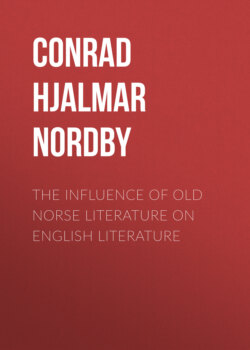Читать книгу The Influence of Old Norse Literature on English Literature - Conrad Hjalmar Nordby - Страница 8
На сайте Литреса книга снята с продажи.
THOMAS GRAY (1716–1771).
ОглавлениеTable of Contents
In the eighteenth century, Old Norse literature was the lore of antiquarians. That it is not so to-day among English readers is due to a line of writers, first of whom was Thomas Gray. In the thin volume of his poetry, two pieces bear the sub-title: "An Ode. From the Norse Tongue." These are "The Fatal Sisters," and "The Descent of Odin," both written in 1761, though not published until 1768. These poems are among the latest that Gray gave to the world, and are interesting aside from our present purpose because they mark the limit of Gray's progress toward Romanticism.
We are not accustomed to think of Gray as a Romantic poet, although we know well that the movement away from the so-called Classicism was begun long before he died. The Romantic element in his poetry is not obvious; only the close observer detects it, and then only in a few of the poems. The Pindaric odes exhibit a treatment that is Romantic, and the Norse and Welsh adaptations are on subjects that are Romantic. But we must go to his letters to find proof positive of his sympathy with the breaking away from Classicism. Here are records of a love of outdoors that reveled in mountain-climbing and the buffeting of storms. Here are appreciations of Shakespeare and of Milton, the like of which were not often proclaimed in his generation. Here is ecstatic admiration of ballads and of the Ossian imitations, all so unfashionable in the literary culture of the day. While dates disprove Lowell's statement in his essay on Gray that "those anti-classical yearnings of Gray began after he had ceased producing," it is certain that very little of his poetic work expressed these yearnings. "Elegance, sweetness, pathos, or even majesty he could achieve, but never that force which vibrates in every verse of larger moulded men." Change Lowell's word "could" to "did," and this sentence will serve our purpose here.
Our interest in Gray's Romanticism must confine itself to the two odes from the Old Norse. It is to be noted that the first transplanting to English poetry of Old Norse song came about through the scholar's agency, not the poet's. It was Gray, the scholar, that made "The Descent of Odin" and "The Fatal Sisters." They were intended to serve as specimens of a forgotten literature in a history of English poetry. In the "Advertisement" to "The Fatal Sisters" he tells how he came to give up the plan: "The Author has long since drop'd his design, especially after he heard, that it was already in the hands of a Person well qualified to do it justice, both by his taste, and his researches into antiquity." Thomas Warton's History of English Poetry was the execution of this design, but in that book no place was found for these poems.
In his absurd Life of Gray, Dr. Johnson said: "His translations of Northern and Welsh Poetry deserve praise: the imagery is preserved, perhaps often improved, but the language is unlike the language of other poets." There are more correct statements in this sentence, perhaps, than in any other in the essay, but this is because ignorance sometimes hits the truth. It is not likely that the poems would have been understood without the preface and the explanatory notes, and these, in a measure, made the reader interested in the literature from which they were drawn. Gray called the pieces "dreadful songs," and so in very truth they are. Strength is the dominant note, rude, barbaric strength, and only the art of Gray saved it from condemnation. To-day, with so many imitations from Old Norse to draw upon, we cannot point to a single poem which preserves spirit and form as well as those of Gray. Take the stanza:
Horror covers all the heath,
Clouds of carnage blot the sun,
Sisters, weave the web of death;
Sisters, cease, the work is done.
The strophe is perfect in every detail. Short lines, each ending a sentence; alliteration; words that echo the sense, and just four strokes to paint a picture which has an atmosphere that whisks you into its own world incontinently. It is no wonder that writers of later days who have tried similar imitations ascribe to Thomas Gray the mastership.
That this poet of the eighteenth century, who "equally despised what was Greek and what was Gothic," should have entered so fully into the spirit and letter of Old Norse poetry is little short of marvelous. If Professor G.L. Kittredge had not gone so minutely into the question of Gray's knowledge of Old Norse, [3] we might be pardoned for still believing with Gosse [4] that the poet learned Icelandic in his later life. Even after reading Professor Kittredge's essay, we cannot understand how Gray could catch the metrical lilt of the Old Norse with only a Latin version to transliterate the parallel Icelandic. We suspect that Gray's knowledge was fuller than Professor Kittredge will allow, although we must admit that superficial knowledge may coexist with a fine interpretative spirit. Matthew Arnold's knowledge of Celtic literature was meagre, yet he wrote memorably and beautifully on that subject, as Celts themselves will acknowledge. [5]
